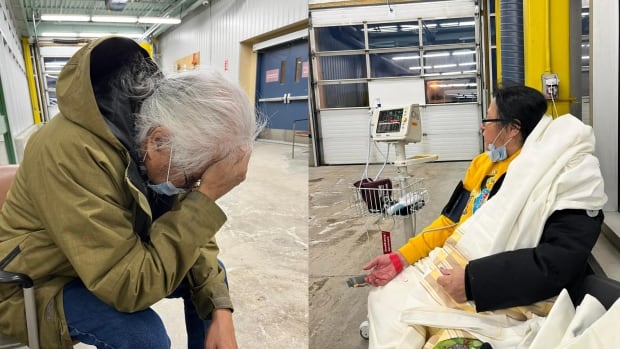
A couple in Winnipeg who went to hospital to be treated for pneumonia earlier this week say they were left waiting for six hours in the cold of a hospital ambulance bay.
Alison Cox, 55, accompanied her 66-year-old husband to the Concordia Hospital urgent care department on Tuesday afternoon, after he had been very ill for days with pneumonia. He was experiencing pain while breathing, was fatigued, and had a fever and chills, said Cox.
She was beginning to come down with pneumonia symptoms as well, she said.
The couple was first met with hesitation from a triage nurse, Cox said.
“She said, ‘Well, why are you coming here? Everyone has viruses. Everyone has the flu,'” said Cox.
“My husband’s very, very sick. That’s why we’re here.”
It was only after the nurse received charts from the couple’s family doctor that she continued with the triage.
The nurse told Cox they would have to be isolated.
According to a spokesperson for the Winnipeg Regional Health Authority, that’s common practice for patients with symptoms of respiratory illnesses like COVID-19, flu and RSV (respiratory syncytial virus), which are currently straining hospitals across Canada.
But Cox and her husband were taken out to the ambulance bay, and told to wait there until there was room inside.
“An ambulance parked where we were sitting. And I’m thinking … we have pneumonia … and now exhaust is in our face,” Cox said.

But as their wait in the ambulance bay continued, Cox began recording their experience on her phone and posting to social media, because she thought nobody would believe what had happened.
After three hours, the couple asked paramedics who had just parked an ambulance in the bay for a blanket.
Four hours passed before someone came by to check their vitals — which is typically done at triage and intake, and then monitored.
Finally, after six hours, the couple was taken into an exam room and saw a doctor.
Cox thinks somebody contacted the hospital after seeing her social media posts, because she overheard staff talking about being ordered to bring them inside.
“Somebody told somebody that we had to get out of that ambulance bay,” she said.
‘Desperate times’: urgent care doctor
Shay-Lee Sweeney says she had a similar experience at the same hospital with her 80-year-old grandmother in the fall.
In October, Sweeney took her grandma, who was sick and progressively getting worse, to Concordia.
She was triaged quickly but told that because she had COVID-19 symptoms, she would have to be isolated.
Sweeney thought they would be taken to a separate room within the hospital, but to her disbelief, they were taken to the ambulance bay.
“I asked [the nurse] if she was serious … and she [said] that she was,” Sweeney recalls.
They waited for about five hours in the bay, which was hot and muggy, with little to no air circulation.
At some point, a paramedic who had come in with an ambulance used a medical glove to cover the overhead garage door sensor so it would stay open and let in fresh air.

“The paramedic got out to transfer her patient and she was like, ‘I cannot believe they still have people in here,'” Sweeney said.
Sweeney says the paramedic told her that sometimes in the winter, they would have to park the ambulance outside the bay and wheel stretchers in the snow to a different door, so they could avoid symptomatic people potentially infected with COVID-19 in the bay.
Sweeney thought that if the hospital could test her grandma for COVID-19, and it came back negative, they could be moved.
But the hospital staff refused.
Eventually, a doctor came out to the bay to check in on her grandma.
“He said, ‘Oh wow, being out here is a first for me. Desperate times, I guess.'”
She asked the doctor if they could be moved inside. He left to check with the charge nurse, but no one followed up.
A few more hours passed before her grandma was taken into a room, diagnosed with pneumonia and sent home.
Both Sweeney and Cox say no one should be left waiting in an ambulance bay while waiting for medical treatment, especially people who are more vulnerable.
“The care that we were given was non-existent,” Cox said.
Ambulance bays used ‘on rare occasions’: WRHA
A spokesperson for the Winnipeg Regional Health Authority said patient privacy laws prevent the authority from discussing specific cases, but said “on rare occasions when all other isolation spaces are full, patients have been required to wait in the ambulance bay for a short time,” until another space is available.
That “has been a common practice across Canada at many sites dealing with larger volumes of patients,” according to the spokesperson.
The Winnipeg Regional Health Authority does not track how often that’s done, but estimates it’s about two or three times per week.
“We recognize the ambulance bay is not an ideal space,” said the statement.
The spokesperson also said initiatives are underway to help with “patient flow issues” at Concordia, including increasing staffing and setting up a designated waiting room area for patients who can’t be isolated immediately.